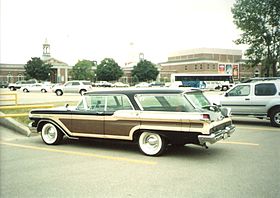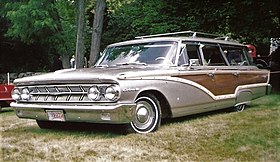The
Mercury Colony Park was the top-of-the-line
full-size station wagon offered by the
Mercury division of
Ford Motor Company between 1957 and 1991. Following the demise of Edsel, the Colony Park became the Mercury equivalent of the
Ford Country Squire and the station wagon version of the
Marquis in 1969. It wore woodgrain paneling on the bodysides and tailgate, a feature also identified with station wagons such as the
Chrysler Town & Country and the
Oldsmobile Custom Cruiser.
1957–1958
For 1957, Mercury followed the practice of Ford in creating a
separate model series for its full-size station wagons; the Colony Park
served as the top model. It came as a pillarless hardtop with simulated
woodgrain siding as standard. Just as on the
Mercury Turnpike Cruiser, the 368 cu in (6.0 L)
Lincoln Y-Block V8 was standard equipment in 1957. An electric clock was also standard.
A padded dash was optional.
This generation of the full-size Mercury station wagons, as with the
non-wagon models, are noted for having a basic body and chassis shared
with no other Ford make with the exception of the 1958
Edsel Citation and
Corsair.
1959–1960
Second generation
 |
| Model years |
1959–1960 |
| Engine |
383 cu in (6.3 L) MEL V8
430 cu in (7.0 L) MEL V8 |
| Transmission |
3-speed Merc-O-Matic automatic |
| Wheelbase |
126.0 in (3,200 mm) |
| Length |
1959: 218.2 in (5,542 mm)
1960: 219.2 in (5,568 mm) |
| Width |
1959: 80.7 in (2,050 mm)
1960: 81.5 in (2,070 mm) |
| Height |
57.8 in (1,468 mm) |
| Curb weight |
4,800–4,900 lb (2,200–2,200 kg) |
|
Along with other full-size Mercurys, the station wagons were updated for the 1959 model year; however, the mid-line
Voyager
was discontinued. With the demise of the premium-model Edsels, the
chassis for the Colony Park was now used solely by the Mercury division.
An update to the chassis and the body gave the Colony Park a 4-inch
wheelbase stretch, to 126 inches. With a curb weight of nearly 5000
pounds, Mercury specified the 315-hp 430 cubic-inch
MEL engine that was shared with Lincoln and the Ford Thunderbird.
Mercury station wagons of this vintage had the longest wheelbase, the
widest bodies and the most cargo space of any station wagon ever built
by this make.
| 1960 to 1970 comparison |
1960 Colony Park |
1970 Colony Park |
| Wheelbase |
126.0 in (3,200 mm) |
121.0 in (3,073 mm) |
| Track Width (front/rear) |
60.0 in (1,524 mm) |
64.1 in (1,628 mm)/64.3 in (1,633 mm) |
| Overall Length |
219.2 in (5,568 mm) |
220.5 in (5,601 mm) |
| Width |
81.5 in (2,070 mm) |
79.8 in (2,027 mm) |
| Height |
57.8 in (1,468 mm) |
56.9 in (1,445 mm) |
| Top Front Seat to Top Tailgate (closed) |
83.4 in (2,118 mm) |
84.0 in (2,134 mm) |
| Top Second Seat to Top Tailgate (closed) |
49.5 in (1,257 mm) |
51.0 in (1,295 mm) |
| Width at Second Seat |
60.8 in (1,544 mm) |
62.0 in (1,575 mm) |
| Floor to Roof (over rear axle) |
34.4 in (874 mm) |
32.0 in (813 mm) |
| Total Cargo Capacity (behind front seat) |
101.7 cu ft (2,880 L) |
96.2 cu ft (2,724 L) |
| Total Cargo Capacity (behind rear seat) |
60.4 cu ft (1,710 L) |
58.4 cu ft (1,654 L) |
1961–1964
The 1961-64 Mercury station wagons were the first since 1956 to share
a body and chassis with Ford. This move was made because of declining
Mercury sales from 1957 to 1960, and despite the obvious Ford origins of
this generation of Mercurys, buyers began to return to the make.
Indeed, the Mercury division's best sales years came during the early
years when the cars were seen as little more than "gussied-up Fords."
1965–1968
In 1965, Colony Park was promoted to "the Lincoln Continental of
station wagons", when it was given the Lincoln Continental's suspension
package (along with its cushy, floaterboat ride). It continued to enjoy
this distinction through its final year.
The 1966 Colony Park was fitted with Ford's two-way "Magic Doorgate",
which was designed to fold down like a conventional tailgate and also
swing sideways like a door. Ford's dual-facing rear seats became
available on the 1967 Colony Park. Mercury also introduced a feature
where windflow was directed across the rear window through channels
integrated and covered with the
"D" pillar. This also allowed fresh air to enter into the rear of the vehicle if the rear window was retracted into the tailgate.
On third-generation Colony Parks, the standard engine was a 390 cu in (6.4 L)
FE V8 with 270 horsepower (200 kW). From 1966 to 1967, the 410 cu in (6.7 L)
FE "Marauder" V8 with 330 horsepower (250 kW) was an option.
|
|

1966 2-way tailgate with side-swing door handle
|
1969–1978
Fifth generation

1974 Mercury Marquis Colony Park
|
| Production |
1969–1978 |
| Engine |
351 cu in (5.8 L) Windsor V8
400 cu in (6.6 L) Cleveland V8
460 cu in (7.5 L) 385 V8 |
| Wheelbase |
121.0 in (3,073 mm) |
|
When the full-size Mercury wagons were restyled for 1969, they were
no longer a separate series, and the Colony Park became a member of the
Marquis
series. In contrast to the Marquis sedan, the Colony Park was based on
the same 121-inch wheelbase as the Ford LTD. Also in 1969, the Magic
Doorgate was reworked to that it could swing sideways without having to
roll the window down.
Although narrower than the 1959–1960 generation, this generation of
the Colony Park was the longest and heaviest of any before or after.
Because of the car's sheer heft, Mercury equipped this generation with a
400-cubic-inch (6.6 liter) V-8 as standard, with a 460-cubic-inch (7.5
liter) optional. For the final model year of this generation, 1978, the
351-cubic-inch V-8 became standard except in California and 'High
Altitude' areas where the 400 was required, although the 400-2V and 460
remained available as options (except that the 460 was not available in
California after Model Year 1976 in any FoMoCo car line), although it
was less than desirable. Most surviving examples carry either of the two
larger engines, as they were far more popular—not to mention more
capable of powering such a heavy vehicle.
Approximately 7,850,000 full-size Fords and Mercurys were sold over 1969-78.
This makes it the second best selling Ford
automobile platform after the
Ford Model T.
1979–1991
For 1979, Mercury joined its
Detroit
rivals in downsizing its largest models. In comparison to its 1978
predecessor, the 1979 model lost slightly over 1,000 lbs in weight, 11
inches in length, 6.6 inches in wheelbase, and 0.4 inches in width;
interestingly, the Colony Park was now taller (by 0.1 inches). With the
downsizing, the former 400- and 460-cubic-inch engines were
discontinued, and the 351-cubic-inch
Windsor
V8 became the largest available in the Colony Park. All Colony Parks
were equipped with standard 8-passenger seating and exterior woodgrain
siding.
The 351 would be dropped after 1982, as most customers deemed the 302
Windsor engine sufficiently powerful. To further enhance fuel economy,
the 4-speed
AOD
overdrive transmission was paired with both engines starting in 1981.
While the carbureted 351 would return in 1986, it would remain a rarely
ordered option. From 1984 on, the Grand Marquis wagon was discontinued,
leaving only the only the Colony Park in the Mercury lineup.
This generation of Colony Park would see few substantial changes
during its 12-year lifespan, garnering only minor grille and trim
revisions annually through 1987. In 1988, the entire front grille
headlamp assembly (shared with the Grand Marquis) was redesigned for a
more modern and aerodynamic appearance, and then in 1990, the instrument
panel was revamped to allow the addition of a driver's side airbag.
|
|
|
1979–1987 Mercury Colony Park front
|
|
|
|
1984 Mercury Colony Park rear
|
|
Discontinuation
When the Grand Marquis was redesigned with aero-styling for 1992, the
Colony Park station wagon was dropped from Mercury's lineup. By that
time, full-size station wagons were no longer popular due to the
increasing popularity of
minivans and
SUVs. The last full-size station wagons, the
Chevrolet Caprice, the
Oldsmobile Custom Cruiser and the
Buick Roadmaster Estate ended production in 1996. In 2005,
DaimlerChrysler briefly reintroduced the
Dodge Magnum name on a full-size wagon, based on the
LX platform Chrysler 300, but it was dropped in 2008.
Source: Internet


















